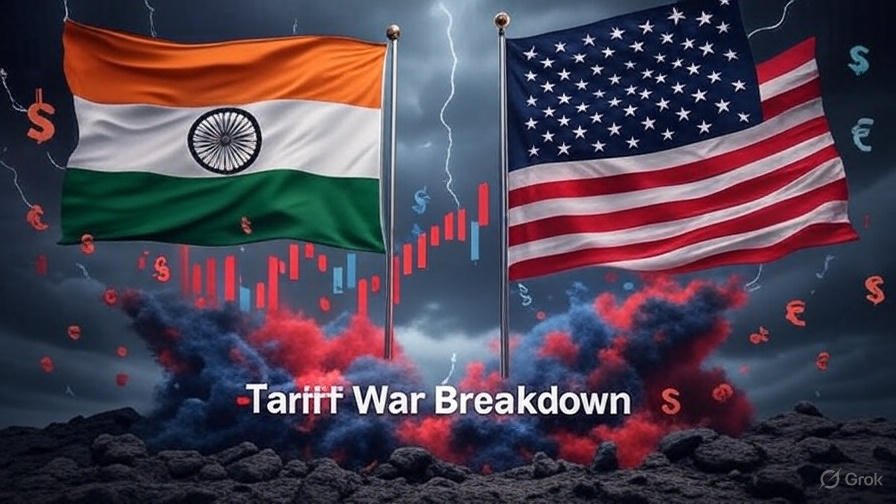Navigating the US-India Tariff Storm: Challenges and Opportunities for Indian Businesses

In 2025, the economic relationship between the United States and India has entered turbulent waters, marked by a significant escalation in the US-India tariff war. The US, under President Donald Trump’s administration, has imposed tariffs ranging from 25% to 27% on Indian goods, citing trade imbalances and India’s energy and defense ties with Russia. These tariffs on Indian goods have sent ripples through bilateral trade, impacting consumers, industries like tech and oil, and India’s broader economy. As Indian businesses brace for challenges, the government is crafting India response strategies to mitigate losses and seize new opportunities. This article breaks down the India trade impact 2025, examines the effects on key sectors, and explores how India is navigating this tariff storm to safeguard its economic future.
Understanding the US-India Tariff War
The US-India tariff war intensified in 2025 when the US imposed a 25% tariff on Indian imports starting August 1, followed by a 27% reciprocal tariff announced in April, targeting India’s $87 billion export market to the US. Information from web sources indicates these measures stem from stalled trade negotiations, India’s high tariffs on US goods (up to 39% on agriculture), and geopolitical tensions over India’s continued purchase of Russian oil, which accounts for nearly 40% of its crude imports. The US views these imports as indirectly funding Russia’s actions in Ukraine, prompting an “unspecified penalty” alongside tariffs.
India, a key US trade partner with $131.84 billion in bilateral goods trade in 2024, now faces a potential $5.76 billion export decline. The tariffs affect sectors like textiles, electronics, gems, and seafood, threatening India’s trade surplus of $45.6 billion. Sentiment on X reflects concern, with posts noting a possible 0.4% US inflation spike and 2 million Indian jobs at risk, though some argue India’s $702 billion forex reserves provide a buffer. This India trade impact 2025 underscores the need for strategic responses to maintain economic stability.
Impact on Trade: A Bilateral Blow
The tariffs on Indian goods have disrupted a robust trade relationship, with the US being India’s largest goods trade partner, accounting for 18% of India’s exports. The 25–27% tariffs, implemented under Trump’s “Liberation Day” strategy, have increased costs for US importers, potentially reducing India’s export competitiveness. Web sources report a projected 6.41% export contraction, affecting $87 billion in goods, including $13 billion in electronics and $10 billion in gems and jewelry.
For US consumers, the tariffs translate to higher prices. A $100 Indian product now costs $125–$127, prompting importers to consider alternatives from countries like Vietnam (20% tariff) or Indonesia (lower tariffs). This shift could erode India’s market share, particularly in textiles (55% US market share at risk) and seafood (20.2% export decline). However, India’s trade surplus and strong forex reserves provide some resilience, allowing it to absorb short-term shocks while pursuing long-term strategies.
Consumer Effects: Rising Costs and Choices
The US-India tariff war directly impacts consumers in both nations. In the US, higher tariffs on Indian goods like textiles, seafood, and electronics lead to increased retail prices. For example, Indian shrimp, a significant US import, faces price hikes, potentially affecting seafood markets in states like Alabama. Web sources suggest US consumers may face a 0.4% inflation spike, with $3–5 billion in additional costs for importers, which could trickle down to households.
In India, consumers may experience indirect effects if export revenues decline, leading to job losses in sectors like textiles and agriculture. Sentiment on X highlights concerns about 2 million Indian jobs at risk, though some argue domestic consumption of goods like leather and spices could offset losses. India’s consideration of tariff cuts on $23 billion in US imports (e.g., gems, auto parts) aims to ease tensions but could increase prices for Indian consumers if US goods become costlier due to retaliatory measures.
Industry Impacts: Tech Sector Challenges
The Indian tech industry tariffs pose significant challenges, as electronics and IT services are key export sectors. In 2024, India exported $13 billion in electronics to the US, but the 26% tariff (up from 0.41%) threatens a 12% export decline. Companies like Tata Motors and Sona Comstar, which supply auto parts, have seen stock drops of 4–5% due to tariff pressures, as noted in web sources. The IT services sector, a cornerstone of India’s $118 billion trade with the US, faces potential tariffs, which could reduce demand for Indian tech exports.
However, India’s tech industry has opportunities. The exemption of pharmaceuticals from tariffs, as reported by web sources, preserves India’s $30 billion generic drug market in the US, providing a competitive edge over European branded medicines. Additionally, India’s role as a manufacturing hub for companies like Apple, planning to export 60 million iPhones in 2025, could mitigate losses if firms shift production to bypass tariffs. Sentiment on X suggests India’s smartphone exports remain strong, competing with China’s higher 30% tariff rate.
Industry Impacts: Oil Trade Tensions
The India oil trade tariffs are a focal point of the US-India tariff war, driven by India’s reliance on Russian crude, which constitutes 40% of its imports. The US has imposed an “unspecified penalty” alongside tariffs to pressure India to reduce Russian oil purchases, viewed as funding Russia’s actions in Ukraine. Web sources indicate India’s refusal to halt these imports, citing energy security for its 1.4 billion population, has escalated tensions.
The tariffs indirectly affect India’s oil trade by increasing export costs, which could strain revenues needed to sustain energy imports. A potential $15–20 per barrel oil price hike if India shifts to non-Russian sources, as suggested by analysts, could hurt India’s economy and fuel inflation. However, India’s measured response, emphasizing strategic autonomy, and its exploration of alternative markets (e.g., Africa, Southeast Asia) for oil exports could stabilize its energy sector. Sentiment on X notes India’s diplomatic restraint as a strategic move to avoid a full-blown trade war.
India’s Response Strategies: Diplomacy and Diversification
India’s India response strategies to the US-India tariff war are multifaceted, balancing diplomacy, trade diversification, and domestic reforms. Web sources outline the following approaches:
- Diplomatic Engagement: India is preparing for a US trade delegation visit in late August 2025 to negotiate a Bilateral Trade Agreement (BTA). The Ministry of Commerce emphasizes a “fair, balanced, and mutually beneficial” deal, prioritizing national interests over rushed concessions on agriculture or dairy.
- Trade Diversification: To reduce reliance on the US market, India is deepening trade ties with Europe, Japan, ASEAN, and Africa. Recent Free Trade Agreements (FTAs) with the UK and plans for EU negotiations provide models for diversification.
- Domestic Reforms: The “Make in India” initiative is pivoting toward export competitiveness, with Production Linked Incentive (PLI) schemes expanding to support textiles, electronics, and pharmaceuticals. The Union Budget 2025 rationalizes customs duties to boost local manufacturing.
- WTO Engagement: India may initiate a World Trade Organization (WTO) dispute to challenge US tariffs, signaling commitment to a rules-based trade system, even if resolutions are delayed.
These strategies aim to mitigate the India trade impact 2025, with analysts suggesting India’s $702 billion forex reserves and low external liabilities offer a buffer. Sentiment on X praises India’s restraint, noting its strategic focus on long-term trade agreements over immediate retaliation.
Opportunities Amid the Tariff Storm
While the US-India tariff war presents challenges, it also offers opportunities for Indian businesses. The tariff exemptions for pharmaceuticals, as noted in web sources, preserve India’s competitive edge in the US generic drug market, potentially offsetting losses in other sectors. India’s textile industry could gain from higher tariffs on competitors like Vietnam (46%) and China (34%), attracting US importers seeking alternatives.
The push for domestic manufacturing under “Atmanirbhar Bharat” could spur innovation in tech and electronics, reducing import dependence. Web sources highlight India’s potential to attract foreign investment as companies like Apple expand manufacturing bases to counter US-China tensions. Sentiment on X suggests a 0.9126% GDP growth increase if India boosts domestic consumption of goods like leather and spices, opening new markets in Africa and Southeast Asia.
Challenges and Risks Ahead
The tariffs on Indian goods pose significant risks. A projected 0.6% GDP slowdown, as reported by web sources, could hinder India’s growth trajectory. The Nifty50 index’s 14% drop and $15 billion in foreign investment outflows reflect market turmoil. Sectors like electronics (12% export decline) and textiles (40–50% US market share loss) face severe challenges, with potential job losses impacting millions.
Geopolitically, the tariff war strains India-US strategic ties, critical for countering China in the Indo-Pacific. Web sources note risks to defense cooperation and the Quad alliance if tensions escalate. India’s refusal to condemn Russia’s actions in Ukraine adds complexity, as the US pushes for alignment. Sentiment on X warns of further tariff hikes if no deal is reached, potentially targeting India’s BRICS membership.
Conclusion: Charting a Path Forward
The US-India tariff war in 2025 is a defining moment for Indian businesses, testing their resilience amid tariffs on Indian goods. The India trade impact 2025 is profound, affecting consumers, industries like tech and oil, and bilateral relations. Yet, through strategic India response strategies—diplomacy, diversification, and domestic reforms—India is navigating this storm with calculated restraint. Opportunities in pharmaceuticals, textiles, and new markets offer hope, but challenges like GDP slowdown and job losses loom large. As India prepares for crucial trade talks, the world watches how it balances economic interests with strategic autonomy. Join the conversation below, share your thoughts on India’s path forward, and explore more economic insights on Mehena to stay informed!





